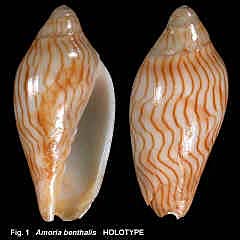|
|
|
|
Amoria benthalis McMichael, 1964 Description: Original description of McMichael (1964): "Shell small, robust, with short spire, the apex bluntly rounded, the suture glazed over; body whorl large, weakly shouldered. Protoconch of 2 whorls, smooth, highly polished, uniform creamish-brown, adult whorls 2½, colour cream, with an ill-defined brown band just beneath the suture and two spiral bands of brown spots, one at the shoulder and one half-way between this and the anterior end of the shell, and with numerous fine, longitudinal reddish-brown lines spaced about 1 or 2 mm apart, slightly undulating, with two peaks at the positions of the bands of brown spots; anterior end of shell suffused with brown. Aperture gaping, white to orange, with four strong plaits; fasciole weakly developed. Animal unknown". Size: Adult specimens 29.5 - 43 mm in length. Distribution: Cape Moreton, Queensland, to Ballina, NSW. Habitat: On muddy sand bottoms, 146-229 m. Rare Remarks: This species is like a dwarf form of A. undulata. A. undulata is normally over 44 mm in length, and rare north of Ballina, NSW. Darragh (1989) considered A. benthalis to be a small end of range form of A. undulata, but Bail & Limpus (2001) report that it differs from dwarf specimens of A. undulata in a number of characters. According to these authors, dwarf specimens of A. undulata taken in the same area as A. benthalis have a more elongate shape with a higher spire, a more triangular protoconch, stronger and more oblique columellar plaits, and a more wavy and more widely spaced pattern. Bail & Limpus (2001, p.44) have reported two unidentified specimens of Amoria from off Wooli, NSW, and Cape Moreton, Queensland. They are adult shells of about 26 mm in length. The shape is similar to that of Amoria necopinata, a species which occurs much further to the north, while the pattern is similar to A. undulata, a much larger species. Fig. 1 Holotype of Amoria benthalis. Off Cape Moreton, Queensland (C.063999)
|
